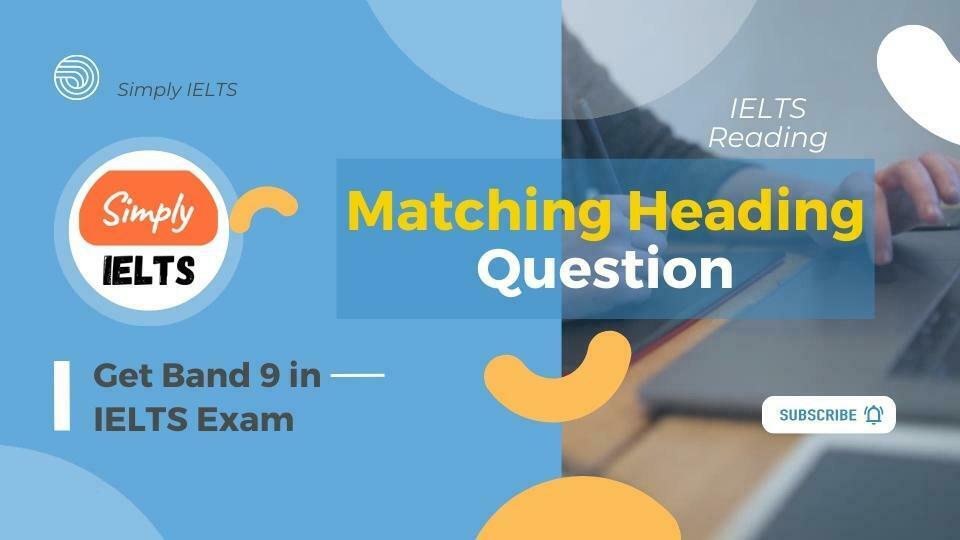How to solve Matching Heading question on IELTS Reading section?

The matching headings question are easily the most confusing type of questions in the IELTS reading section. However, IELTS does not make it easy for you. It lists heading in roman numerals and the paragraphs in alphabetical. While attempting the matching headings question type, I usually advise a little bit of caution.
To solve this question type, it is advised to look at the title of the passage first as it will give you the gist of the passage. Rather than reading all paragraphs, skim them by reading the first sentence of each paragraph carefully. Then try to predict how you may tell your friend what this paragraph is about in 3 to 4 words. Then match your prediction with the given answer choices to reach the final answer. To be a bit more efficient, eliminate unrelated as well as used headings.
Let’s take a sample Matching Heading question.
The given Reading Passage 1 has two paragraphs, A-B.
Choose the correct heading for each paragraph from the list of headings below.
Write the correct number, i-ii, in boxes 1-2on your answer sheet
List of headings
- A proposal to take control away from the driver
- How a concept from one field of study was applied in another
- Areas of doubt and disagreement between experts
It is important to note here that the list of headings contains the answer choices and the paragraphs given below are questions.
- Section A
- Section B
The Physics of Traffic Behavior
A. Some years ago, when several theoretical physicists, principally Dirk Helbing and Boris Kerner of Stuttgart, Germany, began publishing papers on traffic flow in publications normally read by traffic engineers, they were clearly working outside their usual sphere of investigation. They had noticed that if they simulated the movement of vehicles on a highway, using the equations that describe how the molecules of a gas move, some very strange results emerged. Of course, vehicles do not behave exactly like gas molecules: for example, drivers try to avoid collisions by slowing down when they get too near another vehicle, whereas gas molecules have no such concern. However, the physicists modified the equations to take the differences into account and the overall description of traffic as a flowing gas has proved to be a very good one; the moving-gas model of traffic reproduces many phenomena seen in real-world traffic.
The strangest thing that came out of these equations, however, was the implication that congestion can arise completely spontaneously; no external causes are necessary. Vehicles can be flowing freely along, at a density still well below what the road can handle, and then suddenly gel into a slow-moving ooze. Under the right conditions a brief and local fluctuation in the speed or the distance between vehicles is all it takes to trigger a system-wide breakdown that persists for hours. In fact, the physicists’ analysis suggested such spontaneous breakdowns in traffic flow probably occur quite frequently on highways.
B. Though a decidedly unsettling discovery, this showed striking similarities to the phenomena popularized as ‘chaos theory’. This theory has arisen from the understanding that in any complex interacting system which is made of many parts, each part affects the others. Consequently, tiny variations in one part of a complex system can grow in huge but unpredictable ways. This type of dramatic change from one state to another is similar to what happens when a chemical substance changes from a vapor to a liquid. It often happens that water in a cloud remains as a gas even after its temperature and density have reached the point where it could condense into water droplets. However, if the vapor encounters a solid surface, even something as small as a speck of dust, condensation can take place and the transition from vapor to liquid finally occurs. Helbing and Kerner see traffic as a complex interacting system. They found that a small fluctuation in traffic density can act as the ‘speck of dust’ causing a sudden change from freely moving traffic to synchronized traffic, when vehicles in all lanes abruptly slow down and start moving at the same speed, making passing impossible.
Solving section A
We start by reading the first sentence of the paragraph which states ‘Some years ago, when several theoretical physicists, principally Dirk Helbing and Boris Kerner of Stuttgart, Germany, began publishing papers on traffic flow in publications normally read by traffic engineers, they were clearly working outside their usual sphere of investigation’
As the first sentence usually gives a gist of the paragraph, we can use it for the basis of the answer. From the first sentence, we understand that when a couple of scientists had started publishing papers in place that was usually read by traffic engineers, they were working outside their field. From this information, we can start by eliminating the question headings until we get to the correct one. Using this logic, we can mark the second question heading which is ‘How a concept from one field of study was applied in another’ as the correct answer.
Solving section B
We now move on to the next paragraph. As with the first one, we read the first line of the paragraph which says- ‘Though a decidedly unsettling discovery, this showed striking similarities to the phenomena popularized as ‘chaos theory’.
We look at the first heading to see if it fits the paragraph. As it is uncertain from the first sentence, we look at the ending sentence of the paragraph. This is not advisable all the times and should only be done in case the first sentence does not indicate anything. The last sentence reads ‘They found that a small fluctuation in traffic density can act as the ‘speck of dust’ causing a sudden change from freely moving traffic to synchronized traffic, when vehicles in all lanes abruptly slow down and start moving at the same speed, making passing impossible.’ This does fit with the first heading, therefore making it correct for the second paragraph.
Remember to cross out the headings that have already fit with a particular paragraph. This will make it a bit easy for you to know which headings you have already matched. Now, when we look towards the list of headings, we see that only two have been used. There is usually an extra answer choice given to confuse the students. So, if you see that there are some extra answer choices left, do not panic.
We hope you understood the gist of solving the Matching Heading questions.



Responses